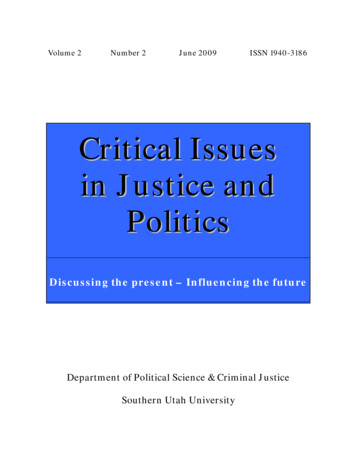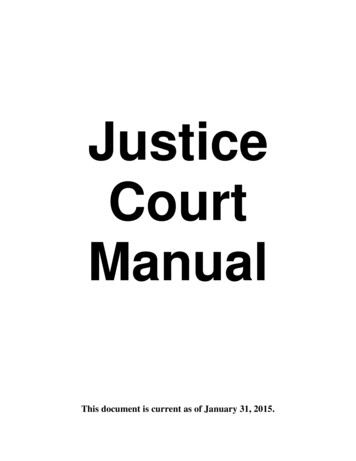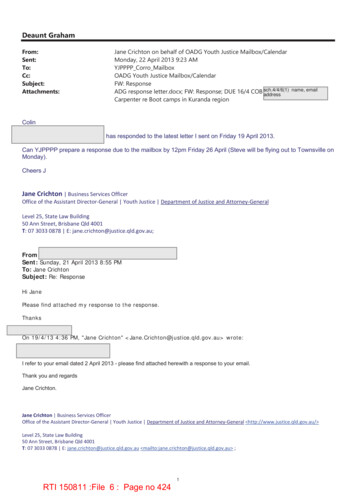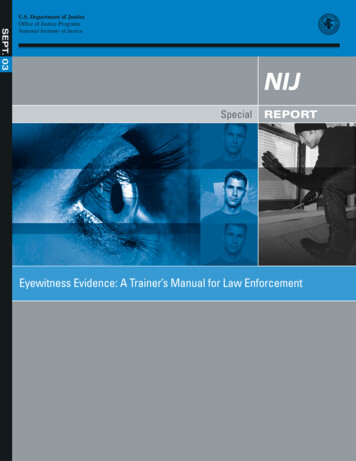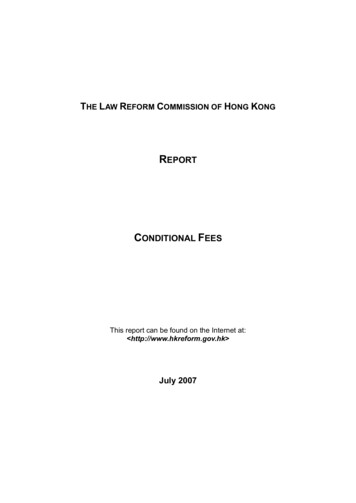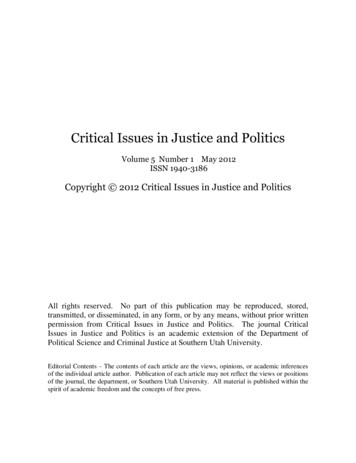
Transcription
Critical Issues in Justice and PoliticsVolume 5 Number 1 May 2012ISSN 1940-3186Copyright 2012 Critical Issues in Justice and PoliticsAll rights reserved. No part of this publication may be reproduced, stored,transmitted, or disseminated, in any form, or by any means, without prior writtenpermission from Critical Issues in Justice and Politics. The journal CriticalIssues in Justice and Politics is an academic extension of the Department ofPolitical Science and Criminal Justice at Southern Utah University.Editorial Contents – The contents of each article are the views, opinions, or academic inferencesof the individual article author. Publication of each article may not reflect the views or positionsof the journal, the department, or Southern Utah University. All material is published within thespirit of academic freedom and the concepts of free press.
2Editorial OfficeDepartment of Political Science and Criminal JusticeSouthern Utah University351 University Blvd., GC406Cedar City, UT 84720Phone: 435-586-5429Fax: 435-586-1925University Webpage: http://www.suu.edu/Department Webpage: http://www.suu.edu/hss/polscj/Journal Webpage: http://www.suu.edu/hss/polscj/CIJP.htmManaging EditorRyan YonkCriminal Justice EditorTerrie BechdelAssociate EditorSandi LevyEditorial Board MembersDavid Admire - Department Chair – Phone: 435 586-1926; OfficeGC406JPolitical ScienceRandy Allen – Phone: 435 586-7949; Office: GC 406EJohn Howell – Phone: 435 865-8093; Office: GC 406HG. Michael Stathis – Phone: 435 586-7869; Office: GC 406KRyan Yonk – Phone: 435 586-7961; Office: GC 406MCriminal JusticeDavid Admire – Phone: 435-586-1926; Office: GC 406JTerrie Bechdel – Phone: 435 865-8613; Office GC 406GCarl Franklin – Phone: 435-586-5410; Office: GC 406LTerry Lamoreaux – Phone: 435-865-8043; Office: TH 109John Walser – Phone: 435-586-7980; Office: GC 406FRon Flud – Phone: 435-586-1921; Office: GC 406AOffice ManagerSandi Levy – Phone: 435-586-5429; Office: GC 406E
Critical Issues in Justice and PoliticsVolume 5 Number 1May 2012ISSN 1940-3186ContentsSubscription Information . iSubmission Guidelines. iiFrom the Editor . ivArticlesGang Investigators’ Perceptions of Military-Trained Gang Members(MTGM)Carter F. Smith and Yvonne Doll . 1Changing Public confidence in the Supreme Court DuringConfirmations: 1971 – 2007Shauna Reilly. 19Should They Stay or Should They Go? Comparing ModernClashes Over SecessionLuke Perry and John Howell . 41Justice from Injustices through Social ConflictsLeonard Mazzone . 61
4
Subscription InformationCritical Issues in Justice and Politics is a refereed (peer-reviewed)journal which contributes to the theoretical and applied nature ofjustice and politics. We are a scholarly journal which requires allarticles to undergo an extensive review process for both content andformat. Our emphasis is on the exchange of qualified material inorder to generate discussion and extend the often limited boundariesof scholarly exchange.Critical Issues in Justice and Politics is sponsored by the Departmentof Political Science and Criminal Justice at Southern UtahUniversity. The editorial board is comprised of faculty from thedepartment as well as select faculty and practitioners from around theUnited States.Published twice a year (March and September) Critical Issues inJustice and Politics focuses on emerging and continuing issuesrelated to the nature of justice, politics, and policy. A specialemphasis is given to topics such as policy, procedures and practices,implementation of theory, and those topics of interest to the scholarand practitioner alike.Nature of Electronic Publication:Critical Issues in Justice and Politics is considered a serialspublication under definitions by the Library of Congress and theInternational Standard Serial Number (ISSN) system. The ISSNnumber, along with identifying information for the serial publication,appears on all copies of the journal. The journal may be obtainedonline or through many of the traditional research databases inacademia.Because we publish online we provide a wider audience than mostsmall, scholarly journals. The cost of other journals can berestrictive; often making purchase and use of the journal difficult for
iithe average faculty member. With our electronic format we provideaccess to the journal at no cost to qualified subscribers. Thisprovides a larger audience with increased opportunity for those whowish to publish.Copies are distributed via email and online access to subscribers first.Authors receive access to the electronic copy and may purchase printcopies.We are an electronic journal which is published using the PortableDocument Format (PDF).Submission GuidelinesCritical Issues in Justice and Politics welcomes submissions fromanyone who can write a high quality scholarly article. We areespecially interested in scholarly, critical, and constructive articleswhich focus on an emerging or continuing issue is justice andpolitics. We also seek review essays (reviews of recent literature ona given topic), reports of significant justice or political issues, bookreviews, and position papers worthy of scholarly review andcomment.It is the editorial policy of Critical Issues in Justice and Politics toaccept submissions from all disciplines so long as the material relatesto justice and politics. We also encourage submissions frompractitioners, students, and others who have an interest in the topics.Simultaneous SubmissionsWe prefer manuscripts which are not under review by other journalsor publications. We endeavor to review all manuscripts in a timelyfashion, so simultaneous submissions are not usually necessary.Refereed submissions are submitted within forty-eight hours ofacceptance and we generally ask reviewers to complete theirii
assignment within 10 working days. In most instances an editorialdecision may be reached within a month of submission.Non-refereed materials usually receive attention within the first weekof submission. An initial editorial decision is often made within 5business days.All papers submitted for refereed publication will be sent to at leasttwo reviewers. We use a blind-review process which submits papersin anonymous format. If there is a clear split between the reviewersthen a third reviewer may be used when necessary for clarification oradditional comment. We do rely very heavily on our reviewers forinsight and recommendations. All of our reviewers hold theappropriate degree and experience to qualify them for the particularproject.Reviewers are asked to evaluate manuscripts on the basis of theirscholarly competence as well as the potential contribution toappropriate theory or related areas. Authors may not contactreviewers during the process, and reviewer names are not disclosedunless the reviewer agrees for such disclosure.Authors who dispute the findings or suggestions of a reviewer maysubmit their response in writing. Final decisions on publicationremain the domain of the editorial board.For more information or to submit an article or other material forreview please see our webpage.Journal Webpage: http://www.suu.edu/hss/polscj/CIJP.htmiii
ivFrom the Associate EditorAs we enter year five of publication, we present the readerwith a dynamic mix of ideas; military-trained gang members,confidence in the US Supreme Court, the issue of secession in theUS, and justices from social conflicts.We would like to take this opportunity to thank, once again,our readers and contributors for making our journey to this pointenjoyable and enlightening, all the while encouraging us to goforward.iv
1Gang Investigators’ Perceptions ofMilitary-Trained Gang Members (MTGM)Carter F. SmithAustin Peay State UniversityYvonne DollNorthcentral UniversityCommunities everywhere have experienced the negative effects of street gangs. The presence ofmilitary-trained gang members (MTGMs) in the community increases the threat of violence tocitizens. The problem addressed in this study was the apparently growing presence of militarytrained gang members in civilian communities. The purpose of the study was to determine theperceived presence of military-trained gang members and to examine whether there was arelationship between the perceptions of gang investigators regarding the presence and the size oftheir jurisdictions, the proximity of their jurisdictions to a military installation, and the extent towhich investigators participate in anti-gang activities. The statistical analyses used to test thehypotheses in this study were Pearson and Spearman Correlation Coefficients, independentmeans t tests, and Ordinary Least Squares (OLS) Regression analysis. Respondents reported amean of 11% of the gang members in their jurisdictions were MTGMs. The Army, ArmyNational Guard, and Army Reserve were identified as the largest sources of MTGMs and theBloods, Crips, and Gangster Disciples were the gangs most represented. Recommendationsincluded all branches of the military therein should adopt a uniform definition of gangs. Militaryleaders should acknowledge the increase in gang-related crime affecting the military and addressthe problems caused for both military and civilian communities without attempting to quantifythe threat level. Military leadership should continuously examine the activities of all suspectedmilitary gang members to determine active gang affiliation for retention purposes whileevaluating any gang affiliation for security clearances. Military Law Enforcement liaison forrecruiters should develop effective communication with local, state, and federal law enforcementagencies to assist with information sharing.Introduction“The greatest concern is gang members in the military recruitingnew members, and using military services (weapons, armor,training material, supplies, access to security levels, and personalaccess to soldiers private data) to further their roles andpurposes. Not only are they being deployed into combat, but theyare also learning new tactics and weapons specializations thatwere unseen in the streets until the last couple of years. ThoseDr. Carter F. Smith (J.D., Ph.D.) is an assistant professor in the Criminal Justice Administration department at austin PeayState University. He is a retired Army CID special agent and was instrumental in identifying the growing gang problemat Fort Campbell, KY in the 1990s, earning the 1994 CID Command Special Agent of the Year award for his efforts. Hisresearch includes a variety of gang issues, and topics related to effectively teaching criminal justice students.Dr. Yvonne Doll (D.M.) is a retired Army Military Police Officer with assignments as CID Commander for Hawaii andthe Pacific Region and Operations Officer for the United States Disciplinary Barracks, Fort Leavenworth, KS. In October2010, she retired from her associate professor of military leadership position at the Command and General Staff Collegeand she currently works as an adjunct professor for Northcentral University, Prescott Valley, AZ.
2GANG INVESTIGATORS’ PERCEPTIONS OF MILITARY-TRAINED GANG MEMBERS (MTGM)tactics and training are now showing up in home invasions andambush style shootings.” Tennessee Gang Investigators’ Association member, May 2010.Communities everywhere have experienced the negative effects of streetgangs, with many communities experiencing an increase in the number of gangmembers. The proliferation of gangs in our society has led to an increase indestructive crimes (Egley & O’Donnell, 2009). Roughly 80% of all crimes incommunities throughout the United States were committed by criminal gangmembers (National Gang Intelligence Center [NGIC], 2009). In 2008, therewere roughly one million gang members in the United States (NGIC, 2009).How many of those gang members have had military training?The number of crimes committed by gang members who were current orformer members of the military has increased in the United States (U.S. ArmyCriminal Investigations Command; CID, 2009). The most common gang-relatedcrimes involved drug trafficking, aggravated assaults, housebreaking andlarceny, attempted homicides, and sexual assaults (CID, 2009). Most militaryand civilian community members are unaware of the existence of Militarytrained Gang Members (MTGM) (NGIC, 2007). The threat to communitiescontinues to increase because all MTGMs were or will be discharged from themilitary at some point, either due to inappropriate activity (e.g. conduct contraryto military discipline, criminal actions) or because their commitment to militaryservice was satisfied. The presence of MTGMs has increased throughout thecountry while advanced combat tactics and advanced military weapons andequipment have become more available to gang members (NGIC, 2007).To some extent, the proliferation of MTGMs is associated with militarydeployments and the transfer of soldiers to geographic areas with no priorMTGM problems (NGIC, 2007). Gang members from the military enteredcivilian communities and introduced military tactics and training to local gangmembers (NGIC). The practice created an increase in the level of gang violencewithin the community. Law enforcement officials with little or no training oncountering military tactics are at great risk of harm (NGIC). Leaders of lawenforcement agencies need to reassess their response to local gang activity andgang-related crimes committed within their jurisdictions (NGIC, 2009;Witkowski, 2004).BackgroundGang membership in the United States is growing. A 2009 report by theNational Gang Intelligence Center (NGIC) reported the number of gangmembers in the United States was conservatively estimated at 1,000,000 as of
CARTER F. SMITH AND YVONNE DOLL3September 2008. The 2009 NGIC estimate represented 212,000 more gangmembers (26% higher) than the 2007 report. The estimate was 215,000 (28%)higher than the number of gang members reported by the National Youth GangCenter in 2006 (Egley & O’Donnell, 2008). The estimate was also 200,000(25%) higher than the 800,000 gang members reported by the Federal Bureau ofInvestigation’s Deputy Director Pistole (2008) in March of 2008.Gang membership has historically been treated as a youth problem.Street gangs were often considered youth-oriented, and were seen as distinctlydifferent from adult criminal organizations (Klein, 2005). The traditionalparameters for gang membership were between 12 and 30 years old, averagingabout 20 years old (Klein, 1995). A recent study found a significant increase inthe average age of gang members in Wichita, KS (Etter & Swymeler, 2008). In acomparative study of police-identified active gang members in 1996 and 2006,membership of adults in the Crips, Bloods, Folk (Gangster Disciples) and People(Vice Lords) gangs and each of the independent local gangs studied showedincreases in the number of older members. The finding indicated that oldermembers were providing an adult perspective to a traditionally youth-orientedproblem (Etter & Swymeler).The average age of gang members in the study increased from 20.03 to26.59 from 1996 to 2006. Along with the age increase, the study revealed thatapproximately 34.87 % of the gang members remained active in the gang for tenyears or more (Etter & Swymeler, 2008). The increased average ages mayindicate not only an aging of the gang population, but also an increased emphasisin the recruiting of older gang members.Military-trained Gang MembersIn 1996, members of a Department of the Army investigative task forcereported that gang-related activities were pervasive in the Army (U.S.Department of Defense [DoD], 1996). In 1998, DoD leaders directed a followup study to the task force report. Flacks and Wiskoff (1998) conducted the studyand reported that gang members adversely affected the military in a variety ofdistinct ways. While there was no official accounting of the scope and nature ofthe problem, leaders of the individual branches of the military thought theproblem was significant enough to publish gang identification manuals (Flacks &Wiskoff). Recruiters and other relevant personnel were in need of betterguidance on gang identifiers and the policies that guided decisions to allow gangmembers to enlist. The goal was to eliminate the possibility that gang memberscan enlist in the military (Flacks & Wiskoff). In addition, due to a decline inoptimal quality and quantity of enlistees due to variables that included a declinein entry-level pay, record lows in the unemployment rate, a rise in college3
4GANG INVESTIGATORS’ PERCEPTIONS OF MILITARY-TRAINED GANG MEMBERS (MTGM)attendance, a rise in family income, recruiters in the military had more of apropensity to recruit from the less-desired population, of which gang memberswere a part (RAND, 2004).Flacks and Wiskoff (1999) also recommended that Tierney’s (1998)research on gang members and military acculturation be expanded to includenon-incarcerated personnel. Tierney examined self-identified gang members inmilitary prisons. The interviews focused on reasons the gang members enlistedin the military and included: truthfulness with recruiters regarding prior arrestsand criminal convictions, links to gangs and extremist groups, and reasons forlack of assimilation and acculturation in the military (Tierney, 1998). The topreason (37.1%) given for enlisting in the military was to get a better life or getout of the current environment. Other reasons included avoiding death or jail asa result of the gang lifestyle, providing for family, and getting job experience(Tierney). None of the military gang members seemed to have had patriotismamong their reasoning for enlisting in the military.Regarding their truthfulness with recruiters, many of the interviewees(over 50%) had prior arrests, including those sealed by juvenile courts. Othermilitary gang members reported that their recruiter encouraged them to concealtheir arrest record (Tierney, 1998). For those who had criminal records, a moralwaiver was sought and granted (Tierney). Many of the interviewees withoutcriminal records admitted to pre-service involvement in criminal activity thatwas undetected by law enforcement. Most of the interviewees were incarceratedfor a crime that was not considered gang-related (Tierney).Gang activity is still a problem in the military. According to the 2009Army CID assessment, members of Los Zetas, Surenos, Bloods, Insane ClownPosse, Crips, Latin Kings, Gangster Disciples, and Bloods were identified duringinquiries and investigations. Members of nearly every major street gang havebeen documented on military installations both domestically and internationally(NGIC, 2007). Gang members were present in most branches and across allranks of the military, but were most common among the junior enlisted ranks.The Army, Army Reserves, and Army National Guard were the most likely tohave gang members in their ranks (NGIC).The authors of the 2006 CID assessment reported an increase in bothgang-related investigations and incidents in 2006 over previous years. The mostcommon gang-related crimes involved drug trafficking, with 31% of the gangrelated felony offenses reported for the year (CID, 2006). Assaults, homicides,and robberies were also reported as gang-related crimes (CID). In theassessment for 2009, the authors reported the most common gang-related crimesinvolved drug trafficking, with 33% of the reported felonies that year (CID).
CARTER F. SMITH AND YVONNE DOLL5Aggravated assaults, housebreaking and larceny cases, attempted homicides, andsexual assault investigations were also reported (CID).Agents of the Air Force Office of Special Investigations (AFOSI)prepared an unclassified report (2007) to document their efforts at intelligencecollection to determine if Air Force personnel or resources were adverselyaffected by gang activity. The agents reported that gang members joining themilitary were a problem over the previous decade (AFOSI, 2007). The agentsreported that gang members were becoming increasingly more sophisticated intheir recruitment of young people, including military dependents, using popularhip hop culture, websites, and chat rooms as methods to recruit young militarymembers. Gang members may seek to join the military for weapons training,and use of combat tactics such as evasive skills and cover and concealmenttechniques (AFOSI, 2007). The training could prove problematic for lawenforcement personnel, if the MTGM employed combat tactics in thecommission of a crime or passed such training knowledge on to fellow gangmembers.The presence of gang members in the military ranks may result in adisruption of command, low morale, disciplinary problems, and a broad range ofcriminal activity. "Gang-affiliated military personnel . . . facilitate crime on andoff military installations, and are at risk of transferring their weapons and combattraining back to the community to employ against rival gang members and lawenforcement officers" (NGIC, 2007, p. 5). Gang members serving in the militaryhave committed crimes such as murder, racketeering, and drug distribution(NGIC). Gang members have enlisted in the military as an alternative toincarceration. Others joined the military to recruit members into their gang,obtain access to weapons, and learn how to respond to hostile gunfire (NGIC).While the presence of gang members in the military is not new, theirnumbers have risen and have recently caught the attention of political leaders.As a result, legislative efforts against those individuals attempting to join themilitary were recently added to a defense-spending bill (National DefenseAuthorization Act [NDAA], 2008). The legislation, Public Law 110-181,included the directive that the Secretary of Defense, “prescribe regulations toprohibit the active participation by members of the Armed Forces in a criminalstreet gang” (NDAA, 2008, Sec. 544). The bill was passed by both houses ofCongress and signed by the President in January 2008. Department of Defense(DoD) Instruction 1325.6 was drafted in response, and required militarypersonnel to reject active participation in criminal gangs, apparently attemptingto limit the activity of MTGMs by using anti-gang prohibitions. At the time thisarticle was written, no policy had been designed by any of the military branchesto address this guidance.5
6GANG INVESTIGATORS’ PERCEPTIONS OF MILITARY-TRAINED GANG MEMBERS (MTGM)Conflicting LoyaltiesMilitary members with simultaneous membership in a street gang have adilemma. On the one hand, they are expected to (and swore that they would)support and defend the Constitution of the United States and obey the orders ofthe President and officers appointed over them (U.S. Department of Defense,2007). Simultaneously, leaders of their street gang require a sworn oath to thebeliefs and laws of the members of their street gang (Knox, 2006). Gangmembers in the military demonstrated a unique condition of deviance: “someonewho literally marches under two sets of colors and to two different drummers,one legitimate (the military) and one illegitimate (the gang)” (Knox, p. 225).The gang allegiance may include retaliation against members of a rivalgang. Many gang members had a dismissive attitude towards authority, and thepresence of gangs have affected all branches of the military (Valdez, 2009).The ability to justify or rationalize conflicting loyalties (membership inboth the military and a gang) were explained by the theories of differentialidentification and organizational commitment. Differential identification allowsindividuals to model behavior that others expected; rationalizing behavior whenrole conflicts existed (Glaser, 1956). Organizational commitment examined anindividual’s dedication to the organization’s purposes and values and his role inthe organization, and indicated that when a member of an organization had apsychological attachment or otherwise identified with the organization,separation from the organization was difficult (Mowday, Porter, & Steers, 1982).The authors of the 2009 NGIC report observed “gang members withmilitary training posed a unique threat to law enforcement personnel” (p. 13).The threat posed to law enforcement was even more significant if MTGMstrained other gang members in weapons, tactics, and planning (NGIC, 2009).Whether trained in combat arms, logistics, finance, or other military occupationalspecialties, the gang member with military experience should be considered moreadvanced and dangerous than the gang member without military experience, andthe potential threat that MTGMs pose to law enforcement is significant (NGIC).All facets of the criminal justice system throughout the United States(police, courts, and corrections) at the local, state, and federal level have thepotential to encounter MTGMs. The military experience added a dangerousdimension to the gang member that was not seen in those without militarytraining.Research Method and DesignThe study was designed to examine a specific type of gang member thathad been neglected in gang research: military-trained gang members (MTGMs).The problem the study addressed was the apparently growing presence of
CARTER F. SMITH AND YVONNE DOLL7MTGMs in civilian communities. The purpose of the study was to determine theperceived presence of MTGMs and examine whether there was a relationshipbetween the perceptions of gang investigators regarding the presence and the sizeof their jurisdictions, the proximity of their jurisdictions to a military installation,and the extent to which investigators participate in anti-gang activities.Because only limited research existed with regard to gang-relatedvariables, the study used the web-based, researcher-developed Military GangPerception Questionnaire (MGPQ) to collect data. The questionnaire wasreviewed by an expert group, pilot tested by gang investigators, and subjected tostatistical analysis to confirm validity and reliability (Smith, 2011). Theindependent variables in the study were the size of the gang investigators’jurisdiction, the extent to which gang investigators participated in anti-gangactivities, and the proximity of the gang investigators’ jurisdiction to a militaryinstallation. The dependent variables were MTGM Presence Based on Ratings,the sum of seven of the questions from the MGPQ, and Percent Presence, whichmeasured the investigators’ perceptions of the percentage of gang members intheir jurisdiction who were MTGMs. Other variables (i.e., anti-gang experience,age, race, and military experience) were assessed as control variables.The MGPQ (Smith, 2011) was used to collect responses from the 260active members of the Tennessee Gang Investigators Association (TNGIA).Members of the TNGIA primarily included male and female adults who workedin or were affiliated with the State of Tennessee in police, courts, corrections,and related fields who joined the association to address the problems seen withthe increased presence of street gangs and other organized criminal operations(TNGIA, 2009).The survey instrument contained indicators that demonstratedinvestigator perceptions of MTGM presence within their jurisdictions. Thesurvey questions specifically referred to the use of military weapons, equipment,and tactics used by gang members in the respondents’ jurisdictions. Therespondents were also asked about the unexplained appearance of new gangmembers or gangs that may indicate a military-assisted migration, and theirknowledge and sources of knowledge regarding MTGMs in their jurisdictions.Data were sought from the population of 260 members of the TNGIA. The finalsample consisted of N 119 participants who answered all or almost all of thequestions on the survey. The survey for the research study was developed foronline distribution.A power analysis was conducted to estimate the sample size needed.Using an online sample size calculator (Creative Research Systems, 2009), aconfidence level of 95%, and a desired precision of 5% for a population of 260gang investigators in the TNGIA, the required sample was 155. An additional7
8GANG INVESTIGATORS’ PERCEPTIONS OF MILITARY-TRAINED GANG MEMBERS (MTGM)sample size calculation was computed for a multiple regression analysisinvolving seven predictors, a significance level of .05, a power of 80%, and amedium effect size (f2 0.15). That power analysis indicated that N 103 wassufficient to detect the size of effect.MTGM presence based on ratings. The first measure of MTGMpresence was MTGM Presence Based on Ratings, a dependent variable. Theanswers provided in questions 4, 5, 6, 9, 10, 12, and 13 were summed into aninterval-level index score that was used to measure the perceptions of MTGMpresence. Those seven items were chosen because (a) they all assessed MTGMpresence, (b) when factor analysis was applied across the Likert items using thepilot study data, those items formed one factor on which they all displayed factorloadings greater than .50, and (c) they demonstrated a very good internalconsistency reliability (Cronbach’s alpha .88).Percent presence. The second measure of MTGM presence was PercentPresence, a dependent variable. This second dependent variable measured theinvestigators’ perceptions of the percentage of gang members in their jurisdictionwho were MTGMs. That was measured by question number 24 on the surveyand consisted of a ratio-level measurement ranging from 0 – 100%. Because thearea of research was new and the survey was being developed by the researcher,using two different operationalizations of the dependent vari
Terry Lamoreaux - Phone: 435-865-8043; Office: TH 109 . Critical Issues in Justice and Politics is a refereed . (National Gang Intelligence Center [NGIC], 2009). In 2008, there were roughly one million gang members in the United States (NGIC, 2009). How many of those gang members have had military training? .
